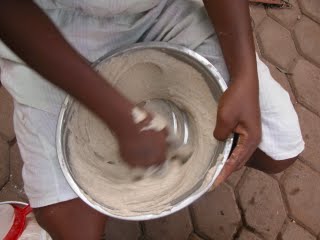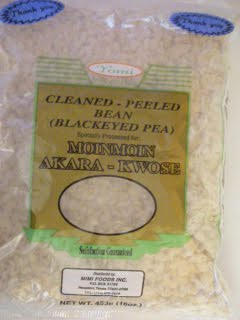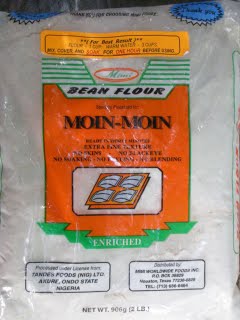Recipe #18: Bean Stew w/smoked fish
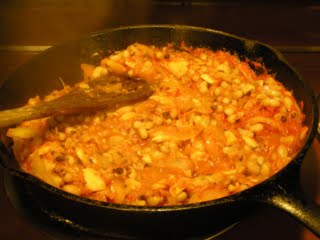 Here's another easy-to-make stew that is perfect with tatale. It also pairs wonderfully with fried ripe plantain, boiled rice, or plain gari.
Here's another easy-to-make stew that is perfect with tatale. It also pairs wonderfully with fried ripe plantain, boiled rice, or plain gari.In Ghana bean (or "beans") stew is commonly prepared with cowpeas, especially a small red type that I would have preferred to use when I made my tatale a few weeks ago. I usually get them from an international market that carries Hispanic foods, but I was out. Sometimes I use aduki beans but they take a longer time to cook.
However, I always have some dried black-eyed peas on the shelf. (Okay, they're not really "beans," but people call them that). If you're not a purist, you can always use frozen or canned cowpeas to speed things up even more. I hadn't pre-soaked my beans, so I just washed and picked over them, brought some water to a boil for a couple of minutes, let it sit for an hour, then drained the water, added more, simmered them until they were soft, and continued with the recipe.
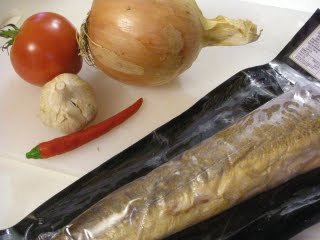
You'll need:
1. a cup of dried cowpeas washed, soaked and cooked (or subsitute one or two cans or packages of frozen black-eyed peas),
2. a medium onion, peeled and chopped or sliced
3. an 8-oz can of tomato sauce (or substitute a cup of fresh chopped or canned tomatoes [pureed if possible], even a small can of tomato paste and half a cup of water will work),
4. 1/2 pound of smoked fish, with skin and bones removed (I like mackerel best, but whiting haddock, whitefish, trout, etc. all work),
5. about 1/4-1/3 cup palm oil if you can possibly get it (or substitute peanut oil or other vegetable oil). If you're new to palm oil, you can use half palm oil and half other vegetable oil). BTW, olive oil is not a West African cooking oil. I don't know of any olive trees in Ghana.
6. 1/2 t (or to taste) salt, optional
7. 1/8 - ? t dried ground red pepper to taste (or substitute fresh chopped hot chili peppers)
8. a couple cloves of garlic, minced (optional)
9. a little fresh ginger, grated (optional)
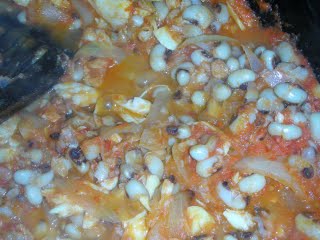
You'll probably begin to notice a pattern if you've been following my stew recipes (meat stew with browned flour or okra, eggplant fish stew) or even the base for things like potluck gari foto. As I've explained elsewhere, one of the basic building blocks in Ghanaian cooking is frying "the ingredients" together to make something similar to Brazil's refogado.
When your cowpeas are ready, and your ingredients prepared:
Heat the oil in a heavy frying pan and add the onion, and cook for a few minutes on medium heat until it's translucent.
If using other fresh seasonings, like ginger or garlic, or fresh chili peppers, add them and stir and cook for another minute before adding the tomato sauce (or tomato, etc.). Break the fish into pieces and add it to the stew, along with the beans and a cup of water and dried red pepper and salt, if using. Remember that the salt in the fish will take a few minutes to flavor the stew. Stir well and allow to simmer while the flavors blend and the sauce thickens. After about 20 minutes taste and adjust salt and pepper if necessary.
Some people mash some of the beans before adding them to the stew, and you can do that if you like a thicker stew.
This is a great "every day" stew: it's easy to make, it freezes well, it tastes even better the next day, and it's easy to make substitutions (use smoked ham cubes or ham hocks if you don't like fish, or use mushrooms to make a vegetarian version, maybe flavored with a little soy sauce? It's also easy to make a large quantity and freeze some for another day to make a quick meal. Also, you can easily add in anything you like (e.g., chopped okra or eggplant or zucchini.). I often omit the ginger and garlic if I'm in a rush. I imagine if you use garlic powder you could try substituting that, but I always have fresh on hand. Fresh ginger has a completely different flavor to me from dried, but ginger is easy to grate and freeze (like in a mini ice cube tray) to always have on hand, too.
I haven't tried it, but bet this would be a good slow cooker recipe if you omitted frying the onions and tomatoes, used ham hocks, and didn't precook the beans. Let me know if any of you try it that way.
Happy cooking.
Labels: bean stew, smoked fish, steamed cowpeas
